Bike: Ricky Johnson’s 1986 Honda RC250
Ricky Johnson is one of America’s all-time motocross legends. In the late 1980s, his factory HRC Honda RC250 was just as famous, and with good reason! This article originally appeared in Transmoto’s 2012 July Issue (#21).
In 1986, at the tender age of 22, Ricky Johnson was a hired Pro on a factory team, racing a bike that was way ahead of its time, earning $100K bonuses and living the American motocross dream. It was an epoch like no other in history, a time when the AMA production rule had barely come into effect and when factory teams had astronomical budgets; a time when privateers racing relatively standard equipment stood little chance of winning.
Managing Johnson’s career on the Factory HRC Honda team was former five-time world champion, the great Roger DeCoster. It was a relationship that spawned multiple national titles across the 250cc and 500cc classes, including the famed back-to-back Outdoor and Supercross crowns in 1986. By the time Johnson retired from Pro-level racing in his prime as a 26-year-old in 1991, he’d amassed seven AMA national championships and taken over the mantel of the sport’s winningest Supercross rider.
In the 21 years that have passed since, both of RJ’s HRC-kitted RC250 (valued at roughly $200K in the 1980s) were wheeled off the track for the last time, but only one race bike survived. Honda crushed the other for fear its factory secrets would get out. And in a stroke of luck, fanatical Victorian-based motocross bike collector, Scott Farrar, managed to hunt down the surviving RC250 to add to his astonishing collection. Usually padlocked and under around-the-clock surveillance, Farrar insisted we take a trip down to his magnificent moto sanctuary and discover for ourselves what makes RJ’s only existing works RC250 so damned special.
IN THE SADDLE
Both the rear brake and gearshift levers were handmade for additional strength over standard. And because the bike produced so much horsepower, HRC hand-built the massive three-core radiators to improve cooling efficiency. The top triple clamp is magnesium and houses eccentric bushings to allow offset adjustments, with varying-offset forged aluminum lower clamps fitted to match. The handlebar clamp is a one-piece magnesium unit and offers two mounting locations. The frame, subframe (although lowered) and swingarm are all OEM, while RJ bolted on a handmade alloy shield to stop his right boot snagging the rear brake master cylinder.
THE MOTOR
The 1985 RC250’s power-valve was electronically controlled and allowed HRC mechanics to alter the power delivery via software. As this was such new technology and, because it was ultra-sensitive, it could often loop the bike out. For 1986, HRC developed a mechanical version called the Honda Power Port (HPP) that tamed the engine down while still allowing custom tuning through adjustable power-valve springs. Inside the engine is the fabled HRC vibration-free crank, as well as works stator, coil and CDI units. The engine cases are machined by hand, while the engine sucks through a works Keihin NT7 carburetor. Unlike the crankcases, crankshaft and cylinder casting, the clutch is the only engine part not a works HRC item.
NICE LINES
The bodywork on Johnson’s RC250 is special issue from Honda’s plastic suppliers and features the original HRC-spec graphics kit. Even the blue CR seat retains the exact foam and cover specification RJ raced with. Every single bolt on the bike and the 51-tooth rear sprocket are handmade from aircraft-grade titanium. The unbranded gold handlebars are Renthal units in RJ’s specified bend – the same model the company now sell under the ‘Honda CR Low’ guise. While the footpegs are crafted from steel, their shape was developed by Johnson and the swingarm features a thicker chain guide. The #5 reinforces the authenticity.
THE SUSPENSION
After constantly swapping between factory upside-down forks and conventional forks during the early rounds of the ’86 Supercross series, Johnson settled on the plush front cartridge-type suspenders seen here. Bob Hannah claims they’re the best forks Showa ever made. Either way, the lower sliders are magnesium and treated with a greenish-brown Kashima coating, while the stanchions are triple chrome-plated for reduced stiction. They also feature adjustable rebound and compression. The shock absorber uses a stock body that was hard-anodised and fitted with a larger shaft, different internals, with adjustable compression and rebound damping.
THE EXHAUST
The original handmade HRC exhaust system that Johnson raced with sparingly was an absolute brute and produced maximum hard-hitting power. Both HRC mechanics and RJ found it was only suitable for Daytona Supercross in the deep sand and for the majority of Outdoor nationals, but for everywhere else it made the bike too demanding to handle. Wanting something a little more forgiving, RJ had Pro Circuit’s Mitch Payton come out for a test session with a collection of pipes and a gas welder. After a day spent hacking, welding and testing exhausts, what they developed was a system that produced better roll-on power and eventually became the chosen set-up that Johnson raced with for the lion’s share of his multiple Honda-backed national championship crowns.
THE DRIVE
Despite its vintage, both the oversized front and
rear wheel hubs are machined magnesium units, laced with large-gauge works spokes to factory rims and then wrapped with factory Dunlop tyres; a wheel package that wouldn’t be out of place today. The 240mm oversized front brake rotor is fabricated from a secret steel formula with pad pressure provided by a works caliper with larger pistons. The lot is then plumbed to a high-volume sand-cast Nissin master cylinder via a steel-braided line. While the OEM CR250RG was shipped with a rear drum brake, RJ’s bike featured the HRC caliper, rotor and steel-braided line carried over from the works 1985 model.
IN DETAIL WITH RICKY JOHNSON
Transmoto: Ricky, how do the factory bikes and levels of testing in the late ’80s compare with race bikes these days?
RJ: When I started racing for Honda, I rolled up for the first testing session with my teammates, David Bailey and Johnny O’Mara. Both their bikes were so trick – full of parts I’d never seen before – and here I was with my worn out practice machine, thinking I was going to get some hand-me-downs. Then all of a sudden, the team mechanics rolled out a new race-spec 250 for me. It was like a Christmas I’d never forget. At that point, we had four or five pipes, multiple cylinders, different frames, triple clamps and swingarms … basically a whole bunch of stuff that all needed testing. The bikes back then weren’t nearly as refined as they are now from new, and I think some of those testing sessions were even more intense than what they are nowadays. I don’t even think the adjustability of those late-1985 full works Hondas can be compared to what they have now straight out of the crate.
Did you ever get a chance to ride the full-works 1985 HRC RC250 … the machine the 1986 RC250 was based on?
Yeah, I did. That’s actually what Roger DeCoster and the Honda team baited me with. You know, I was literally about to jump on a plane to fly to LA to sign my contract with Yamaha for the ’86 season. So I cancelled the flight and met the Honda team – who had a Showa shock specialist along with them, a guy they called Tano – to test the ’85 machine. Within the first few laps, I was already five seconds a lap faster. I signed on the spot for a base salary of roughly $100K, with additional $100K bonuses for each championship I won. And, you know, being the egotistical type of guy I am, I raced both the 250 and 500cc classes!
How many HRC RJ RC250s exist?
We were only ever supplied two whole race bikes. The first was crushed by Honda in Japan. The other went to Australia and is the bike featured here. Honda presented me with an RC250 when I retired in 1991. It wasn’t even my actual race bike; it was originally David Bailey’s RC250 with my numbers on it.
—
Want to view this article in magazine form? Grab yourself a print or digital edition of Transmoto Dirt Bike Magazine’s 2012 July Issue (#21).
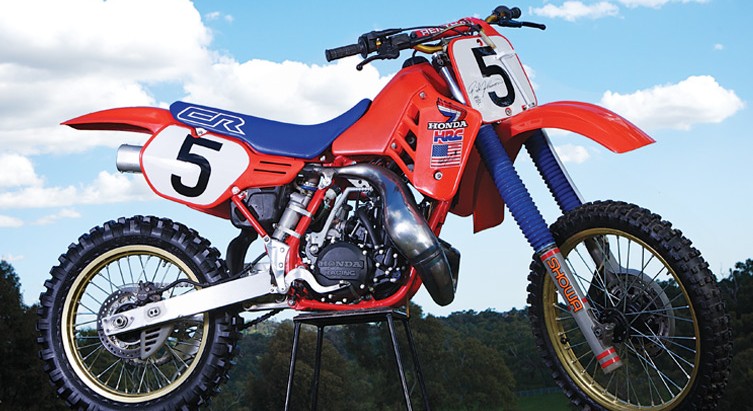
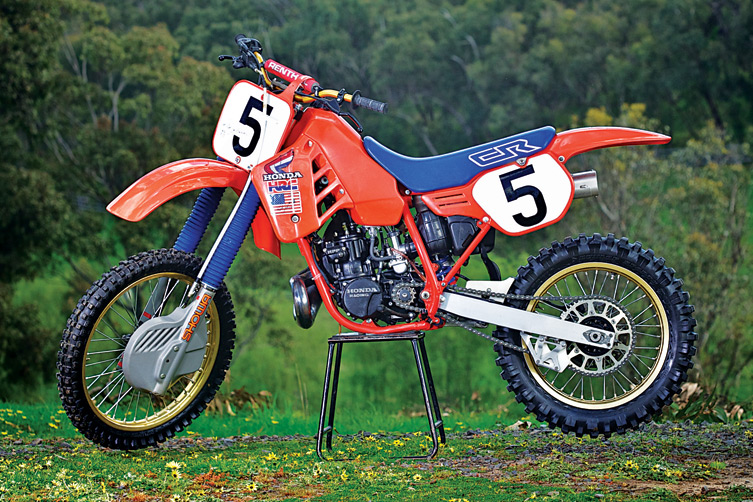
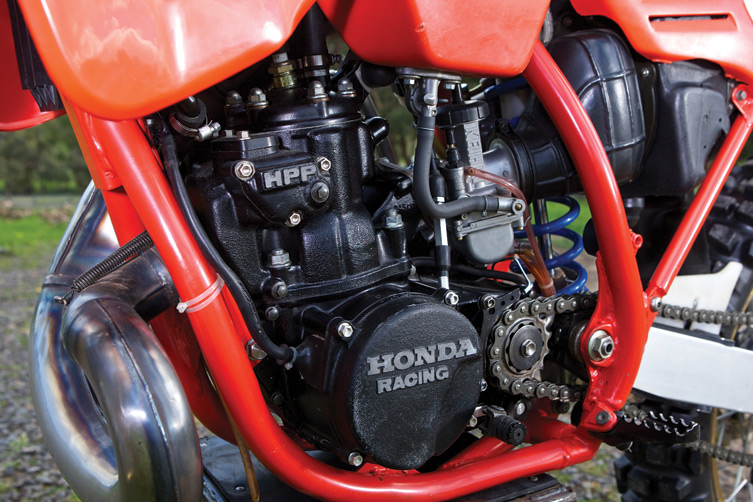
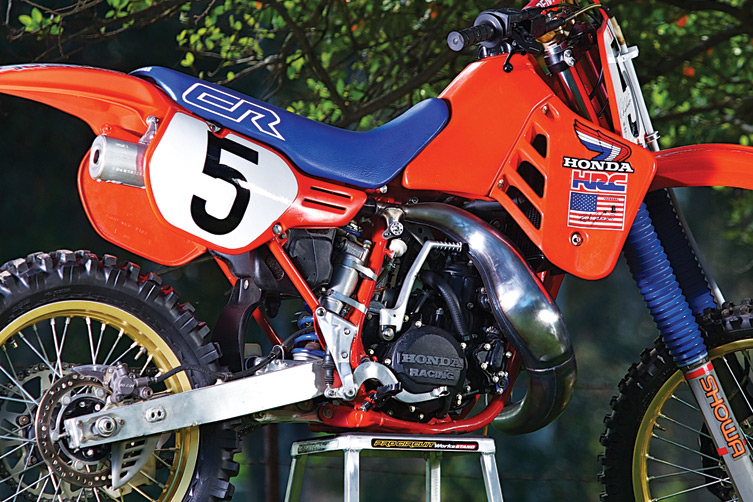
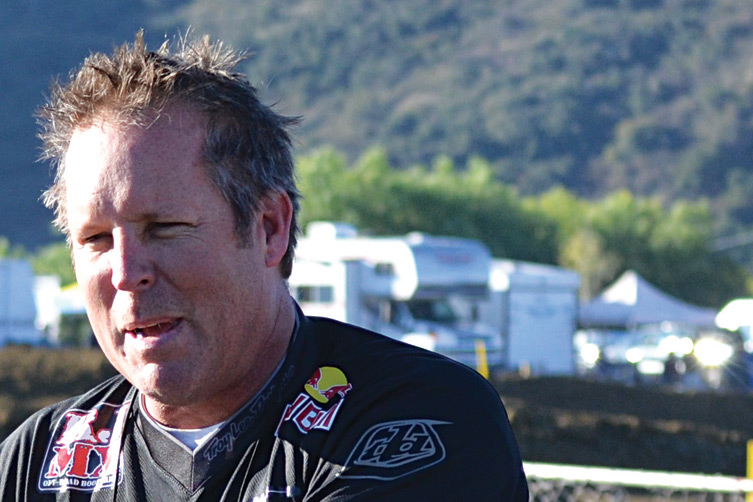
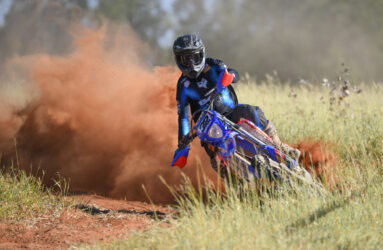
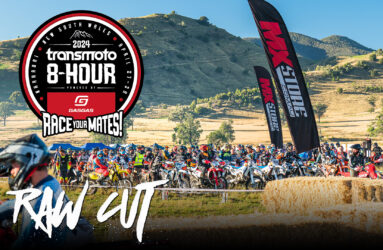






Be the first to comment...